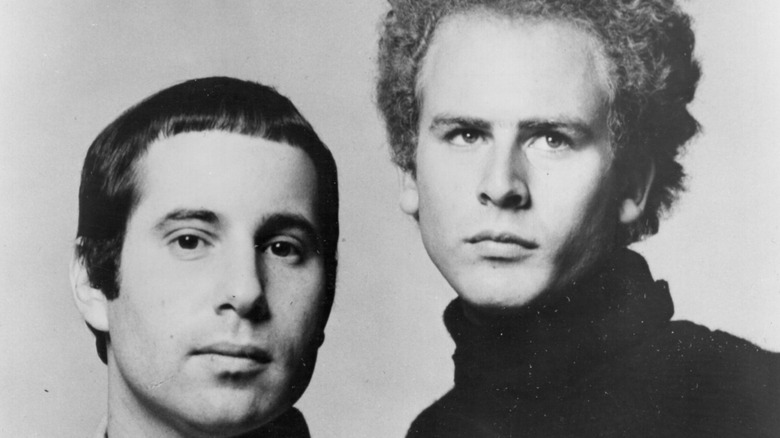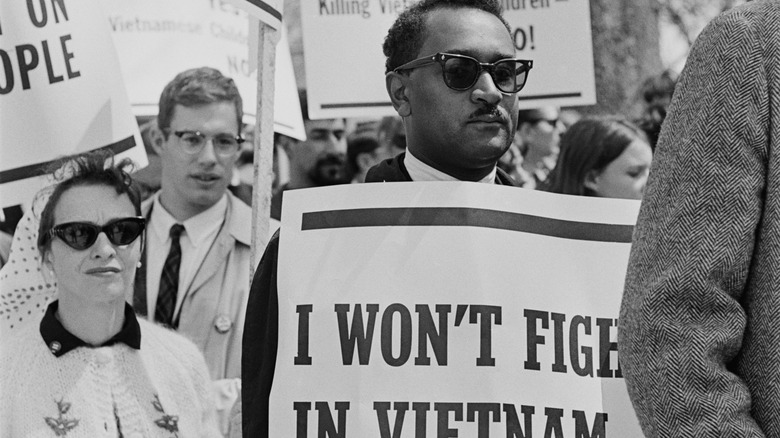The Fascinating History Behind Simon & Garfunkel's Scarborough Fair
Long before Paul Simon performed it on "The Muppet Show," "Scarborough Fair" was a traditional British folk song. Simon had learned the song in the early 1960s from British folk singer Martin Carthy, who had also taught the song to Bob Dylan, according to the BBC. Dylan later incorporated elements of it into his song "Boots of Spanish Leather," as well as using the line "Remember me to one who lives there, she once was a true love of mine" in "Girl from the North Country" (via Song Facts).
When Simon & Garfunkel released the song, they didn't credit Carthy or acknowledge that it was a traditional tune, which caused some hard feelings. Simon told Mojo Magazine in an interview that "it was naivety on [his] part" not to give credit where it was due and said the group arranged a settlement with Carthy's publisher, but Carthy ended up not getting any of the money (via Far Out). Simon and Carthy eventually reconciled when Simon invited Carthy to play "Scarborough Fair" with him in 2000 in London.
Simon & Garfunkel's version
Martin Carthy had learned the song from a Ewan MacColl songbook which was created as MacColl traveled around learning folk songs from ordinary people. He and partner Peggy Seeger had heard "Scarborough Fair" from different sources, and Seeger's version of the song was derived from samples collected by Cecil Sharp in Southern Appalachia. MacColl's version, however, which Carthy learned and recorded, was collected from Mark Anderson, a retired lead miner from Teesdale, Yorkshire, England (via The Balladeers).
In the Simon & Garfunkel version, the song is interwoven with "Canticle," which is based on an earlier Paul Simon song called "The Side of a Hill," according to Polyphonic and Song Facts. This song describes the countryside in which a battle is ongoing and the accidental death of a child. It has a strong anti-war message inspired by the Vietnam War. The combination of this with "Scarborough Fair's" themes of lost love create a melancholy parallel. The two songs are played simultaneously using a technique called counterpoint that's common in Western classical music.
The song's background
"Scarborough Fair" well predates even Ewan MacColl's and Peggy Seeger's sources. It may originally be from the 18th century, according to the BBC. It's possibly based on an even older song, allegedly dating from the latter half of the 17th century, called "The Elfin Knight." Like "Scarborough Fair," it contains the concept of a lover setting impossible tasks for their suitor (via The Balladeers).
One theory about the mention of herbs in the song is that they were used to ward off an unwanted supernatural suitor like the elfin knight, according to The Balladeers. Polyphonic says others believe the line is simply a placeholder for an older, now-lost line. Another theory is that the herbs represent values the lover needs to succeed in their tasks. Parsley could represent the removal of bitterness, while sage represents strength, rosemary love, and thyme courage (via Polyphonic and Song Facts). Others even think they may be the ingredients of a love potion or associated with the death of one of the lovers, according to Far Out.
The song refers to the town of Scarborough, on the English coast in North Yorkshire. According to Polyphonic, the town hosted a fair beginning in the mid-13th century that attracted sellers and entertainers from all over the country. Though the fair ended in 1788, the song lives on.


